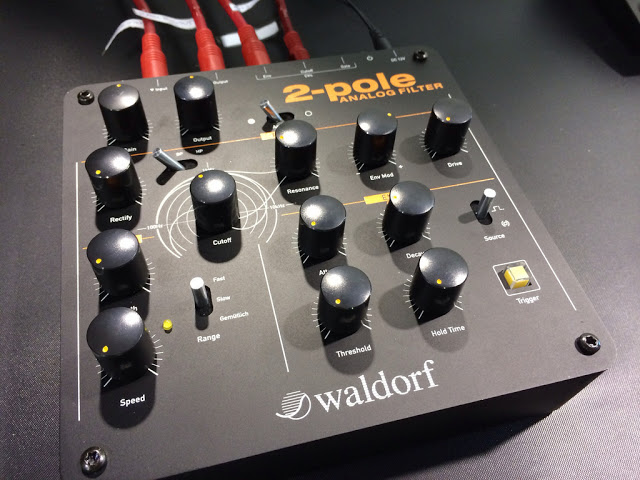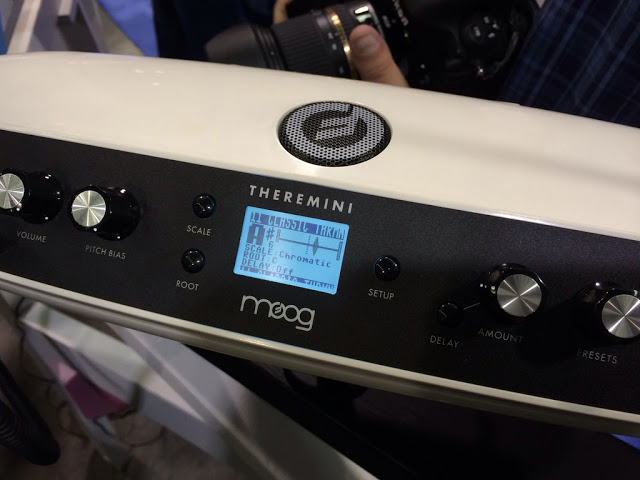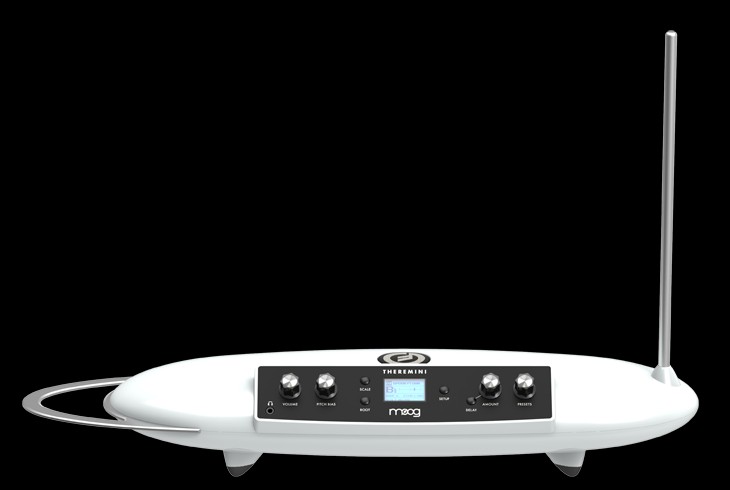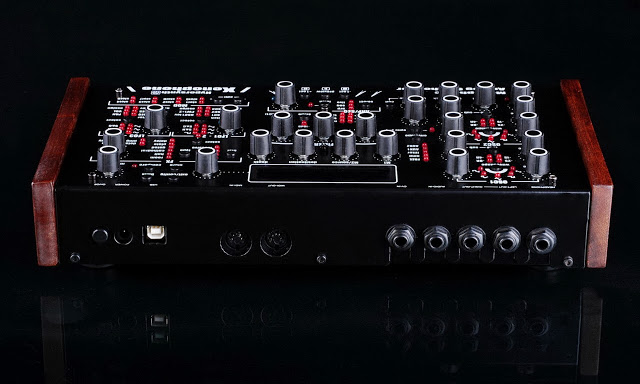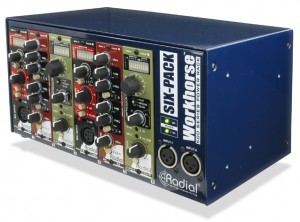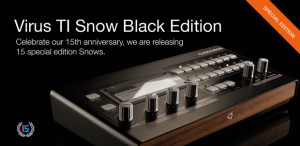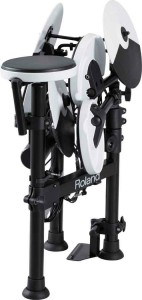The new filter from Waldorf and Theremini from Moog
“Waldorf’s mystery knob is the filter control from a big filter in a box.
That’s right, Waldorf is introducing a 2-pole filter. And one heck of a 2-pole filter it is:
Filter with cutoff and resonance, but also a Drive setting, Rectify, and switchable between low-pass, band-pass, and high-pass
LFO with Depth and Speed
LFO set to Fast, Slow, and (hilariously) Gemütlich (kinda hard to translate, actually easy-going and slower than slow)
Envelope controls: Attack/Decay/Hold, threshold, a source (hard to tell what that does), and trigger.
And it takes CV for envelope, cutoff, and gate, with jack plugs for input and output.”
“Then there’s Moog, who are introducing, as rumored, a new Theremin. And this isn’t just any Theremin: it’s a Theremin that can assist you in keeping things in tune, all whilst looking like a space-age egg from Woody Allen’s Sleeper.
It’s a Theremin with presets. Crazy presets.
It’s a digital instrument with Theremin-style controls. (Readers who speculated, you guessed right.) It’ll upset purists, perhaps, but this is rather cool: it’s based on the unique-sounding Animoog sound engine.
The synth is digital, but the input is analog: classic heterodyning style, then digitized as control signal for the engine. Onboard MIDI, CV output (presumably pre-digitization, in fact), and USB. But that engine gives you more different ways to play.
Yes, there’s a display, scale and root controls, a Presets knob, plus built-in delay. There’s a built-in speaker and headphone jack, as well, for convenience.
Price: US$299 estimated is what we heard on the floor…”
Product descriptions from our colleagues at CDM
“The Theremini is a re-imagination of one of the oldest electronic musical instrument in history, and Bob Moog’s first love – the theremin. Its design fuses the experience of performing with an instrument you don’t actually touch, with a powerful sound engine derived from Moog’s award winning synthesizer, Animoog. The Theremini guarantees immediate success to any player at any skill level, while providing new ways to experiment with music, education, and gestural control.
Assistive pitch correction allows each player to adjust the instruments level of playing difficulty. At the maximum position, the Theremini will play every note in a selected scale perfectly, making it impossible to play a wrong note. As this control is decreased, more expressive control of pitch becomes possible. When set to minimum, the Theremini will perform as a traditional theremin with analog heterodyning oscillator and absolutely no pitch assistance.
A built in tuner supplies real-time visual feedback of each note as it is played, as well as its proximity to perfection. This is useful for correcting a users playing position, or to educate younger players about pitch and scales.
The presets section allows you to select from 32 wave or wavetable-based patches, store a selected scale & root note, set and recall a specified playing range, and specify per-patch settings for the included stereo delay.
Recessed in the top of the Theremini is a compact speaker perfect for private rehearsal and quick setup anywhere. Silent rehearsal is also possible via front panel headphone jack. Simply plug in ear-buds or headphones and the built in speaker becomes silent.
For live performance and gestural control, the rear panel features two line level audio outputs, a pitch CV output with selectable range, and a mini USB jack for MIDI I/O and connectivity.
Xenophone – New Monophonic Analog Hardware Synth from HyperSynth
Here are all the details:
Synth-Engine:
Xenophone is an advanced analog mono-synth with 100% analog signal path. It has three oscillators, two subs, three ring modulators, one multimode VCF and analog distortion, all based on discrete analog circuits followed by a high quality stereo digital delay and reverb. The extensive modulation capabilities of the sound engine plus the warm and unique character of Xen’s filter enriched by built-in analog distortion make it the best choice for creating deep basses, aggressive leads, transparent and crisp synth lines, acid sequences, complex arpeggios, punchy percussive sounds, extreme SFXs and more. Besides the synthesis capabilities, it can be used as a powerful audio processor to colorize an external input signal by analog filter, distortion and DFX.
Control and User Interface:
26 encoders and 27 buttons put all the major parameters easily reachable with no menu diving. The Encoders smoothly turn and provide you 96 steps per rotation that mimic pot’s feeling and sweep range. The layout is designed in a way to be simple and intuitive. Using 88 LEDs and a free-angle OLED display, it is easy to get the idea of the current preset at a glance. Master Tempo and all LFOs have blinking LEDs that show the BPM and rates. The presets can be previewed without external keyboard using 3 buttons in 3-octave range or pre-defined notes. User interface is easy to learn and creative with no useless bells and whistles. You can get a huge sound out of the box only with a few tweaks and changes.
Enclosure and Connectivity:
Xenophone has a rigid Aluminum enclosure that comes with a pair of vintage style hand-made wooden side panel that made out of maple wood in two options: flat and tilted.
The box connects to the outside world using 2x balanced outputs (stereo), 1x headphone jack, 1x external input, 1x CV input, MIDI in/out, USB and DC power in.
MIDI and DAW Integration:
Xenophone can function as a standalone instrument or fully programmable synth. It responds to the standard MIDI messages plus dedicated CC and NRPNs. The maximum implemented resolution in NRPN mode is 12bit, 4096 steps for filter frequency that provides super smooth sweep over the frequency range in compare to 127 steps CC standard!
The computer integration is an important feature of a modern synth that plays vital role in the studio. Xenophone comes with a software editor called: XEditor. Using this editor you can control and automate every parameter of the sound engine remotely via MIDI and storing your patches on your PC and vise-versa. It also helps you in deep and precise editing the patches. “XEditor” will be available as standalone and VST plug-in.”
http://www.hypersynth.com/xenophone.html
Kinetik Laboratories Drone demo
Kinetik Labs produces some really interesting hardware machines for Drone Music. At the last Turin Synth Meeting, Andrea Reali and Claudio Granzieri plays and demonstrates their pretty dense drone instruments. Enjoy.
Roland MSQ-700, Bit 99 and TR-505
Jamming with the Roland MSQ-700, a simple but effective hardware sequencer from 1984. A (Crumar) Bit 99 offers the synth sounds, and a Roland TR-505 provides the beat.
In the days before DAWs, hardware sequencers were often used to build the structure of synth-based songs of the ’80s.
Using MIDI Hardware with Reason – Micro Tutorial
More info on Reason: https://www.propellerheads.se/product…
The Reason Rack offers nearly endless sonic capabilities. But what if you just want the sound of your favorite hardware synth? Or that weird little drum machine you got half-price. In this tutorial we take a look at the External MIDI Instrument and how it can help you expand your Reason rack with your hardware.
Tutorial: How To Play Hardware Synths in Ableton Live
External instruments can easily be played inside of Ableton Live. Enjoy this Ableton Live Quick Tip in which AfroDJMac shows you how to set up an external instrument, such as the Synthboy ( http://ninstrument.com ). Once inside Ableton, it can be sequenced and effects can be added to further the potential of your hardware synthesizers!
Visit his site for more stuff like this, including Live Instrument downloads, tutorials and music! http://www.afrodjmac.com
Sanyo DP 10 Synthesizer Card Player Review
The Sanyo DP 10 is a card player synthesizer from the early 80s. Yamaha released a series of keyboards around the same time and Sanyo appears to have taken that technology into their unit. Like the Yamaha keyboards they accept cards that have a magnetic strip the reader recognizes and plays a pre-programmed song. The cards features songs such as Dancing Queen, Londonderry Air, etc and a head cleaning card. The DP 10 can also mix signals into the unit via the 2 mic inputs and an auxiliary input to play along with another instrument or sing through a mic. You can also adjust the tone or change the tempo of he song. There is also a rhythm section for 10 different styles of music, such as march and disco, jazz and bossa nova.
Radial Engineering has announced the SixPack Workhorse
Radial Engineering is pleased to announce the SixPack, the latest Workhorse power rack designed for the popular 500 series module format.
500 Series Range
The SixPack is Radial’s sixth power rack in their ever growing 500 series range. Add this to the 15 modules that are currently available and it is clear: Radial has certainly taken a most proactive stance with respect to building and supporting the 500 series standard. According to Radial President Peter Janis: “Given today’s ever changing digital environment, recording studios must be agile for them to adapt and they must also bring a higher level of creativity and uniqueness to the recording process. We believe that the 500 series is perfectly suited for this new reality as it is compact and easily transportable. And when you consider the hundreds of modules that are now available plus the tremendous patching options that can be put to use, there has never been a more exciting time to be involved in music production.”
Six Slots Rack
The SixPack is a 6-slot power rack designed to accommodate all 500 series modules including older ones made by API. It features a hefty 1600 milliamps of current for more than 265 milliamps average power per slot. This lets you mix and match solid state and tube modules without concern about powering. The external supply also provides 48V phantom power for mic preamps. Protective circuitry in each slot safeguards the SixPack and other connected modules against malfunction or short circuits.
The design begins with 14 gauge steel construction for added durability and improved shielding against noise. Modules may be patched in series using the FEED switch and stereo mated using the LINK function. Extra connectivity includes ¼” TRS connectors wired in parallel with the XLRs for cross-patching and parallel processing. These are also wired in parallel to a set of D-Sub connectors for easy patching to and from the workstation. Two front panel XLR convenience jacks let you access channels 7 and 8 on the D-Sub or may be assigned to channels 1 and 4 to create a stereo channel strip. Separate ground lugs on the rear panel enable the system tech to incorporate star grounding or other schemes into the studio design. Optional mounting hardware lets you recess the SixPack into the workstation or angle mount it for a more ergonomic set up. The same hardware works double duty to enable the SixPack to be mounted into a standard 19″ rack.
(Via GJs)
The SixPack will start shipping January 2013. For more information on the SixPack
Looking good – the new Access Virus TI Snow Black Edition
The Virus TI series comes in different flavors. You’re looking for something ultra compact and yet powerful? The sturdy Virus TI Snow features exactly the same sound engine like its bigger Virus TI brothers. It fits on an issues of Time magazine and has proven itself to be an ideal companion for musicians on the road or with limited desktop estate.
The Snow features 4 multimode parts and about 50% of the polyphony in comparison to the bigger models. Those result in everything in between 10 and 50 voices cranking out the same powerful signature sound like all other Virus TIs. Each and every voice can use up to four oscillators in parallel including Virtual Analogue, Wavetable, HyperSaw and Grain Oscillator models.
The filter section comprises two independent multi-mode filters with optional Mini Moog emulation and self-resonance. An extensive array of parallel effects enable you to compose highly complex sounds in virtually no time.
In Multi mode, your patches sound 100% identical and include all of the effects. The 4 independent parts can be routed to 1 Stereo Analogue or 3 USB outputs streaming audio directly into your sequencer workstation. The software suite includes a VST, RTAS and AU compatible plug-in allowing for total recall, sample-accurate timing and modern automation features.
The audio inputs and outputs can be optionally used as a sound card in your sequencer. The hardware knobs can be used to either control the Virus’ sound engine or compatible third party software plug-ins.
Roland introduces easy-to-transport TD-4KP V-Drums Portable electronic drum set
Roland has announced the TD-4KP V-Drums Portable, a compact, easy-to-transport electronic drum set with a unique and innovative folding design. They tell us that this new set offers players the industry leading V-Drums sound and performance with maximum mobility and ultra-quick setup time.
The TD-4KP features a kick pad, a snare pad, three tom pads, and three cymbal pads (crash, ride, and hi-hat). An FD-8 Hi-Hat Controller pedal is included as well. Roland says that the 7.5-inch snare and tom pads feature a cushioned rubber surface that provides a sensitive, accurate response and natural playing feel.
All the drum and cymbal pads are mounted on a durable, integrated stand that folds into a surprisingly small size for transport and storage. To put the kit back into playing position, the user simply unfolds the stand and pads.
Roland tells us that the included TD-4 Percussion Sound Module delivers a wide range of expressive drum and percussion sounds that can be easily edited, allowing players to quickly customize their kits. Ambience effects optimized for drums are included for lively, dynamic performances. The Coach and Quick Rec/Quick Play functions are ideal for effective practice, providing drummers with valuable feedback for rapid improvement.
An optional CB-TDP Carrying Case provides a convenient way to transport and protect the TD-4KP. The custom-designed bag features a shoulder strap and detachable pouches for the FD-8 and a kick pedal, plus handy pockets for a kick beater, drumsticks, and other accessories. Users can also swap out the snare pad with an optional PDX-6/8 for a true mesh head feel and dual-triggering capability.
A Roland spokesperson told us, “With its extremely portable fold-away design, great V-Drums sound, and expressive playing feel, the TD-4KP is a perfect fit for a wide range of users, from young students to drum teachers to gigging players. Its versatility and small footprint makes it ideal for many different environments, including bedrooms, apartments, lesson studios, rehearsal spaces, and more.”
Pricing and Availability:
TBC
More information:

